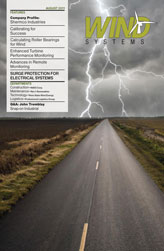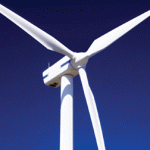Components of wind turbines are affected by asymmetric loads, variable wind speeds, and severe weather conditions which cause wind turbines to change their states. A typical wind turbine undergoes various states during its daily operations. The wind turbine states follow a certain pattern, such as: 1) turbine OK to run-up idling; 2) turbine online to maintenance/repair mode; 3) turbine weather conditions to external stop, and; 4) turbine OK to fault mode, and so on. A state change from normal turbine operations to a fault mode adversely impacts the performance of wind turbines and its components. Monitoring these states can greatly augment the maintenance operations.
Wind turbine monitoring can be done in two ways: condition-based, and performance-based. Condition monitoring requires installation of additional equipment/sensors to continuously monitor relevant parameters in real time. Performance monitoring utilizes historical data for prediction of turbine performance. Since performance monitoring relies on the existing data, there is no additional cost to the wind farm operators. Analyzing the historical data through data-mining techniques is a promising approach to performance monitoring. The current SCADA systems already record wind turbine parameters. An improved SCADA system coupled with data-mining algorithms can be useful in identifying critical performance indicators of wind turbines. This article demonstrates application of data-mining techniques to prediction of fault modes of a wind turbine.
Turbine States Information
In addition to wind turbine parameters, a SCADA system records the states of wind turbines. Consider 17 possible states in which a turbine can be found. The state “turbine in fault mode” (state No. 17 in Table 1) can usually be expressed in more than 400 ways. Components of a wind turbine such as wind turbine blades (e.g., blade angle asymmetry), turbine yaw (e.g., yaw runaway), wind turbine generator (e.g., generator brush worn), and wind turbine gearbox (e.g., gearbox over-temperature) can be affected. Using domain knowledge, the states listed in Table 1 can be broadly categorized into four main groups (Figure 1). At the top level, prediction of fault modes of wind turbine is crucial in identifying an actual fault.
Figure 2 displays the distribution of wind turbines states. The values are averaged for a wind farm over a year period. Almost 90 percent of the time the turbine is operating normally. However, faults make up 6.82 percent of the total time. Any effort to minimize the frequency of faults would enhance wind turbine availability.
Developing Prediction Models
In this section, data-mining models are developed for predicting turbine states. The data collect by the SCADA system is sampled at the frequency of 0.1 Hz. The faults that have occurred at 17 wind turbines in a three-month period are plotted in Figure 3. Based on the frequency of fault modes, three wind turbines are identified (labeled as A, B, and C in Figure 3). Data from turbine A is used for training and testing data-mining algorithms, whereas turbine B and C are used for performance evaluation.
Parameters for States Prediction
A SCADA system records various parameters, which can be categorized into: 1) non-controllable parameters such as wind speed and wind deviations; 2) performance parameters such as power output and rotor speed; 3) vibration parameters such as tower acceleration and drive train acceleration, and; 4) temperature parameters such as gearbox temperature and generator temperature. It is important to mention that not all the parameters are causing wind turbines to change its states. Therefore, we need to identify a set of parameters that impact the wind turbine states. This is the place where algorithms build using data-mining techniques are useful. Data-mining algorithms use statistical measure such as information gain and correlation coefficient to identify relevant set of parameters. Table 2 shows 10 parameters relevant to wind turbines states (data from turbine A), identified by three different data-mining algorithms. The techniques used are wrapper with genetic search (WGS), wrapper with best first search (WBFS), and boosting tree algorithms (BTA). For detailed description of these techniques refer to [1-3].
Data-Mining Models
A combination of relevant input parameters (found in previous section) can be used to develop prediction models for state faults. The evaluation of data-mining algorithms is based on the prediction accuracy of turbine states namely turbine OK (TO), weather downtime (WD), maintenance downtime (MD), and fault mode (FM) (Figure 4). The diagonal elements (e.g. TPTO, TPWD) are correctly predicted turbine states, whereas non-diagonal elements are wrongly predicted (e.g., FPFM, MD: turbine in fault mode is predicted as turbine in weather downtime).
Data-mining algorithms namely random forest algorithm (RFA) [4] is used to build eight prediction models at various time stamps, with the maximum prediction length of 5 min. The selection of data-mining algorithm is based upon their performance on training data at time stamp t. The accuracy was found to be in the range 81-99 percent for all turbine states (Table 3).
Robustness of Data-Mining Models
In order to check the robustness of developed models, various unseen faults were tested. The aim is to check the response of the model when unobserved faults are encountered. Figure 5A (a-b) Figure 5B displays the distribution states for turbines B and C plotted over a three-month period. The number of faults varies across turbines, however, turbines are found to be operational most of the time. The results shown in Table 4 and Table 5 illustrate the response of data-mining algorithms on turbine A and B. Except of the gearbox-related faults, other fault modes of wind turbines are correctly identified.
Conclusion
The parameters recorded by SCADA systems can be useful for monitoring purposes. Using prediction models derived by data-mining algorithms the states of wind turbines can be predicted ahead of the time, which can be helpful in maintenance planning. The models built using data-mining algorithms can be integrated with current SCADA system to enhance performance monitoring of wind turbines. Acknowledgement: The research reported in the paper has been supported by funding from the Iowa Energy Center, Grant 07-01.
References:
1) Kohavi, R. and John, G.H., 1997, “Wrappers for feature subset selection,” Artificial Intelligence, 97(1-2), pp. 273-324.
2) Sbihi, A., 2007, “A best ï¬rst search exact algorithm for the Multiple-choice Multidimensional Knapsack Problem,” Journal of Combinatorial Optimization, 13, pp. 337-351.
3) Kudo, T. and Matsumoto, Y., 2004, “A Boosting Algorithm for Classiï¬cation of Semi-Structured Text,” EMNLP.
4) Liwa, A. and Wiener, M., 2002, “Classification and regression by random forest,” R News, 2(3), pp. 18-22.








































